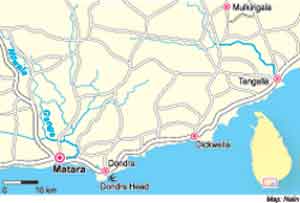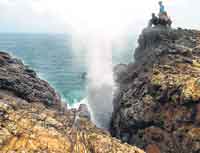| ‘Ho,
ho, ho and a big whoosh!”
It’s an experience that shouldn’t
be missed on a journey to the deep South, writes Lankika de Livera
of the famous “hummanaya”
The “Hummanya” blow hole is a well-known
attraction in the deep South of the country and it certainly lives
up to expectations. Seeing it was an exhilarating experience and
one that shouldn’t be missed.
 |
| Route to Hummanya |
So how do you get there? Passing the Matara town
and after Dickwella, one has to turn right at Kudawella and proceed
about 1.1 km. Residents in the area offer to take care of your vehicle
at a nominal fee.
About a 20-minute trek along newly built shallow
steps brings you to the spot. All along the way little kiosks sell
cool drinks and the fresh catch of the area – fish! The batter
fried preparation of different kinds of fish, was delicious.
The
grandeur of Mulkirigala |
Of particular interest in this area is the Mulkirigala
rock temple famous for its ancient rock paintings and sculptures.
To get there, turn left at Dickwella towards Mulkirigala
and take a right turn near the clock tower at Beliatta junction.
It is a distance of 9 km to the temple.
The Handbook of the Ceylon Traveller describes Mulkirigala
thus:
“To the North of Tangalle is Mulkirigala which has
an air of awesome grandeur about it, rare in this modern
world. The black rock thrusting more than 300 feet into
the sky has tucked into its side an ancient and hallowed
temple. The rocky path to this pre-Christian temple is steep
yet well worth climbing. Though beautiful and carefully
preserved, the murals in this temple are not its claim to
fame. Here less than 150 years ago was discovered the ‘key’
to the Mahavamsa and Chulavamsa, chronicles which have recorded
the story of this island from 543 B.C. to modern times.
It was the scholarly George Turnour, erstwhile Government
Agent of Ratnapura, who discovered here this valuable tika-
the commentary which permitted the translation, first into
English and four years later into Sinhala, of the Pali chronicle.
The discovery was made in 1826 and together with his guru
thera Galle, the Englishman unfolded to historians of Sri
Lanka and the world twenty-three centuries of the island’s
history.”
Monkeys sit in the wayside jungle as one climbs the steps
to the temple. Villagers from the area sell local oranges
and an abundance of woodapple. It is a historic temple which
should definitely be visited if one is in the area.
|
Even from far away, one can hear the sounds of
the blow hole. There are intermittent periods of silence and then
there are sounds similar to the faraway rumbles of thunder –
“Ho-ho-ho”. This is when the pressure builds up. Then
after a while one hears the delightful sound of the spray as it
hisses high up-almost 120 feet into the sky at times.
 |
| Hummanaya |
Reaching our destination, what greeted us was
a large expanse of rocky cliffs. In the middle, there seemed to
be a split, within which was a fissure (a long narrow cleft or crack)
– through which the water came shooting up, like a tall fountain
that appeared momentarily with a huge ‘whooshing’ sound.
Once in every 10-15 minutes or so, the water pressure
builds up to give out the stunning spray. Waiting for that moment
can be quite tense, especially if one is hoping to capture it on
film as it is over in a flash. I had to click many times and wait
a long while to capture a few good shots. But I could have gone
on waiting for hours, so special was the moment. For the hour of
so that we were there, the spray reached up to about 120 feet once,
while at other times it was less.
Going back down the steps one feels tempted to
eat more of the delicious fish, salayas, kumbalawas and even sprats
strung together on ekels- all batter fried and then wash it down
with a cool Ginger Beer.
Before heading back home, we also visited the
Dondra Head lighthouse. One has to turn right at Devinuwara and
proceed 1.2 km to come to this, the southern most tip of the country.
The beach surrounding this area is beautiful and
one can spot many rock pools with colourful fish swimming among
the green seaweed.
|

